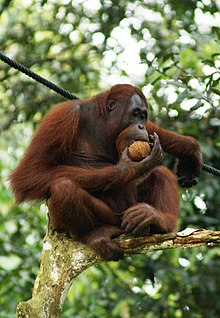Hominoid
| Hominoids or Apes Temporal range: Miocene–Holocene |
|
|---|---|
 |
|
| Bornean orangutan (Pongo pygmaeus) | |
| Scientific classification | |
| Kingdom: | Animalia |
| Phylum: | Chordata |
| Class: | Mammalia |
| Order: | Primates |
| Suborder: | Haplorhini |
| Parvorder: | Catarrhini |
| Superfamily: |
Hominoidea Gray, 1825 |
| Type species | |
|
Homo sapiens Linnaeus, 1758 |
|
| Families | |
|
†Chororapithecidae |
|
†Chororapithecidae
†Proconsulidae
†Afropithecidae
†Pliobatidae
Hylobatidae
Hominidae
Apes (Hominoidea) are a branch of Old World tailless anthropoid primates native to Africa and Southeast Asia. They are the sister group of Old World monkeys, together forming the catarrhine clade. They are distinguished from other primates by a wider degree of freedom of motion at the shoulder joint as evolved by the influence of brachiation. There are two extant branches of the superfamily Hominoidea: the gibbons, or lesser apes; and the hominids, or great apes.
Recent evidence has changed our understanding of the relationships between the hominoids, especially regarding the human lineage; and the traditionally used terms have become somewhat confused. Competing approaches re methodology and terminology are found among current scientific sources. See below, History of hominoid taxonomy and see Primate: Historical and modern terminology for discussions of the changes in scientific classification and terminology regarding hominoids.
Except for gorillas and humans, hominoids are agile climbers of trees. Their diet is best described as frugivorous and folivorous, consisting mainly of fruit, nuts, seeds, including grass seeds, leaves, and in some cases other animals, either hunted or scavenged, or (solely in the case of the humans) farmed—along with anything else available and easily digested.
...
Wikipedia
